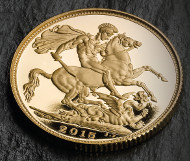May 14, 2015 – The dramatic depiction of St George conquering the dragon is an image that has long been associated with The Sovereign – but how did England’s Patron Saint come to span 198 years on The Royal Mint’s flagship gold coin?
St. Georg in St. Mary’s Church, Sandwich/Kent.
St George has been the Patron Saint of England since Medieval Times, and it was towards the end of that period, in 1489, that Henry VII instructed The Royal Mint to produce ‘a new money of gold’ – the original Sovereign – a statement piece, which featured an enthroned portrait of the king himself. Thereafter, The Sovereign was struck in turn by each of the Tudor monarchs, before its issue came to an end under the rule of James I.
The classical image of St George and the dragon by Benedetto Pistrucci, the Italian-born Royal Mint Engraver, first appeared on coins during the reign of King George III. The Napoleonic Wars had left Britain financially unstable, so the recoinage of 1816 was implemented with the aim of steadying the country’s currency by tying it to the value of gold. Pistrucci’s distinctive St George design was used on a new 22-carat gold coin valued at 20 shillings, or one pound, which was given the old ‘Sovereign’ name.
St George’s appearance on The Sovereign was not continuous: it was interrupted in 1825, when his image was replaced by more conventional heraldic designs, but he returned once more to the coin in 1871. This principal gold coin of the United Kingdom went on to become recognised and traded as currency across the globe, referred to as “the chief coin in the world”. By the turn of the century more than 100 million gold Sovereigns were estimated to be in general circulation in the United Kingdom alone.
The Royal Mint continued to strike circulating gold Sovereigns on a decreasing scale until 1917, by which time it had largely disappeared from circulation, as it was in demand for First World War ‘war effort’ funds.
When regular minting of Sovereigns resumed in 1957 there was no thought to replace the classic design, so St George has appeared on every Proof and bullion Sovereign of The Queen’s current reign, with the exception of just four special occasions (1989 – the 500th anniversary of the original Tudor Sovereign, 2002 -The Queen’s Golden Jubilee year, in 2005, and in 2012 – The Queen’s Diamond Jubilee).
St George on the Gold Sovereign 2015.
The Sovereign, with its iconic figure of St George, has progressed from acting almost entirely as a circulating coin to one that is valued globally. It appeals to Bullion Sovereign purchasers because of its unrivalled reputation for accuracy, fineness and purity, whilst Proof and Brilliant Uncirculated Sovereigns are sought after as quality collectable coins, and year-dated gifts for special occasions.
It was Pistrucci’s St George that was selected to feature on the Silver Proof Crown struck to commemorate the birth of Prince George of Cambridge – the first time that the George and the Dragon design had featured on a silver crown since the beginning of the reign of Edward VII over 100 years ago.
When St George met his end on 23 April 303 AD at the hands of the pagan Emperor Diocletian, he could not have imagined that almost 1,700 years later, he would not only be the Patron Saint of England, but also the iconic figure who has spanned 198 years on The Sovereign, the world’s oldest surviving coin still in production.
To visit the website of The Royal Mint please click here.
More information on life and death of St George you may find here.






